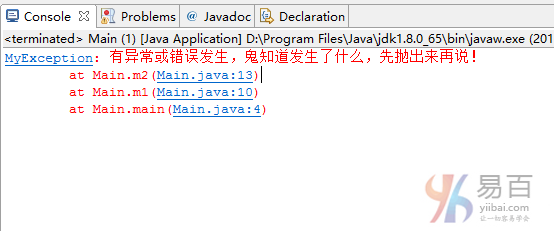Java自定義異常
我們可以創建自己(自定義)的異常類。它們必須擴展現有的異常類。
<Class Modifiers> class <Class Name> extends <Exception Class Name> {
}<Class Name>是異常類名。在接下來的示例中,將創建一個MyException類,它擴展了java.lang.Exception類。
語法
自定義一個異常類的語法如下:
public class MyException extends Exception {
}異常類與Java中的任何其他類一樣。 通常不向異常類中添加任何方法。許多可用於查詢異常對象狀態的有用方法已經在Throwable類中聲明瞭。
自定義異常類構造函數
通常,異常類包括四個構造函數。所有構造函數將使用super關鍵字調用其超類的相應構造函數。
class MyException extends Exception {
public MyException() {
super();
}
public MyException(String message) {
super(message);
}
public MyException(String message, Throwable cause) {
super(message, cause);
}
public MyException(Throwable cause) {
super(cause);
}
}第一個構造函數創建一個具有null的異常作爲其詳細消息。
第二個構造函數創建一個具有詳細消息的異常。
第三和第四個構造函數允許通過包裝/不包含詳細消息的另一個異常來創建異常。
自定義異常類之後,就可以拋出MyException類型的異常。
throw new MyException("Your message goes here");可以在方法/構造函數聲明中的throws子句中使用MyException類,或者在catch塊中使用參數類型。
public void m1() throws MyException {
}或捕獲異常類
try {
}catch(MyException e) {
}Throwable類
下面的列表顯示了Throwable類的一些常用方法。Throwable類是Java中所有異常類的超類。此表中顯示的所有方法在所有異常類中都可用。
方法
方法描述
Throwable getCause()
返回異常的原因。如果未設置異常的原因,則返回null。
String getMessage()
返回異常的詳細消息。
StackTraceElement[] getStackTrace()
返回堆棧跟蹤元素的數組。
Throwable initCause(Throwable cause)
設置異常的原因。有兩種方法可以將異常設置爲異常的原因。 其他方法是使用構造函數,它接受原因作爲參數。
void printStackTrace()
在標準錯誤流上打印堆棧跟蹤。
void printStackTrace(PrintStream s)
將堆棧跟蹤打印到指定的PrintStream對象。
void printStackTrace(PrintWriter s)
將堆棧跟蹤打印到指定的PrintWriter對象。
String toString()
返回異常對象的簡短描述。
實例-1
以下代碼演示了使用異常類的printStackTrace()方法。
public class Main {
public static void main(String[] args) {
try {
m1();
} catch (MyException e) {
e.printStackTrace(); // Print the stack trace
}
}
public static void m1() throws MyException {
m2();
}
public static void m2() throws MyException {
throw new MyException("有異常或錯誤發生,鬼知道發生了什麼,先拋出來再說!");
}
}
class MyException extends Exception {
public MyException() {
super();
}
public MyException(String message) {
super(message);
}
public MyException(String message, Throwable cause) {
super(message, cause);
}
public MyException(Throwable cause) {
super(cause);
}
}上面的代碼生成以下結果。

實例-2
以下代碼顯示瞭如何將異常的堆棧跟蹤寫入字符串中。
import java.io.PrintWriter;
import java.io.StringWriter;
public class Main {
public static void main(String[] args) {
try {
m1();
} catch (MyException e) {
String str = getStackTrace(e);
System.out.println(str);
}
}
public static void m1() throws MyException {
m2();
}
public static void m2() throws MyException {
throw new MyException("有異常或錯誤發生,鬼知道發生了什麼,先拋出來再說!");
}
public static String getStackTrace(Throwable e) {
StringWriter strWriter = new StringWriter();
PrintWriter printWriter = new PrintWriter(strWriter);
e.printStackTrace(printWriter);
// Get the stack trace as a string
String str = strWriter.toString();
return str;
}
}
class MyException extends Exception {
public MyException() {
super();
}
public MyException(String message) {
super(message);
}
public MyException(String message, Throwable cause) {
super(message, cause);
}
public MyException(Throwable cause) {
super(cause);
}
}上面的代碼生成以下結果。
